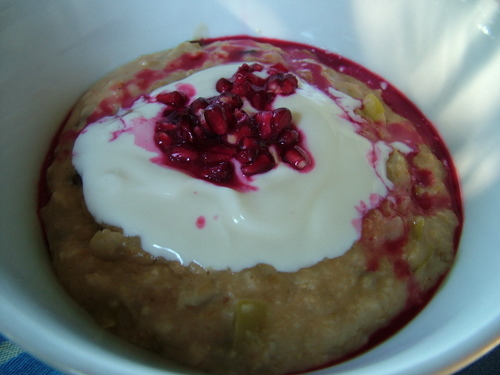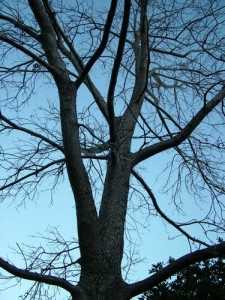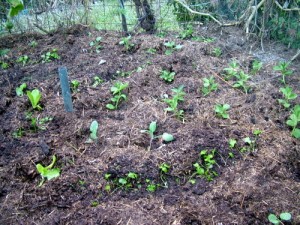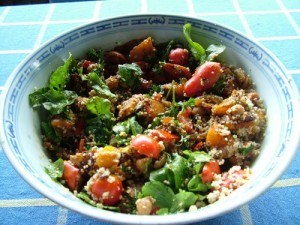This is porridge to convert non-porridge eaters!
I’m not a huge porridge fan normally. I know oats are really really good for you – full of fibre, lower bad cholesterol, lots of B vitamins, good range of minerals, phytochemicals, etc etc. And the kind of soluble fibre – beta-glucan – slows both the rise in blood glucose and the fall. So it keeps you feeling not just full but also clear-headed and energetic and not craving a sugar hit at morning tea time. But I find ordinary porridge just a bit too bland unless you add lots of sweetener which undoes the benefits of the low GI.
Apples are right in season now, just for another month or so, and they’re hugely healthy too, with phytonutrients called polyphenols that protect against a range of diseases. I’ve topped it with pomegranate, just because I had a fresh picked one and it made it look beautiful! And home-made low fat yoghurt, yet another superfood.
It takes just 5 minutes, literally, to make in a pressure cooker, but only 10 minutes or so even in a pot.
(The Breakfast Cereal Challenge is my 2011 challenge – a year’s worth of breakfast recipes that are quick and easy enough to be a real option for weekdays, and that are preferable, in nutrition, ethics, and taste, to the overpackaged, overpriced, mostly empty packets of junk food marketed as “cereal” .)
The Recipe:
This recipe makes one adult or teenager sized serve. Multiply by as many people as you need.
It’s the little detail bits that really make this.
- Put ½ cup of plain rolled oats (not quick oats) in a bowl and pour over 1½ cups of boilng water. Let it soak for a minute
- Dice 1 green apple into small but not tiny dice – about 12 mm.
- Melt one teaspoon of butter and one teaspoon of honey in a pressure cooker.
- Add the apple and a pinch of cinnamon, and fry for just a minute stirring just once, till the apple absorbs the butter and the bottom of the pot starts to brown. (You want caramelisation, not stewing).
- Pour in the soaked oats, and add
- little pinch of salt
- little squeeze of lemon juice (a teaspoon or so)
- a dessertspoon of sultanas (organic ones are worth it)
- Put the lid on the pressure cooker, bring to pressure, and pressure cook for 2 minutes. Or, in a pot, simmer for 7 or 8 minutes.
Serve with a good dollop of plain yoghurt, and quarter of a pomegranate if you want to be fancy!




Yum! That looks good. My kids and hubby eat porridge for breakfast (son has rice porridge), but it’s not really my kind of thing. This looks tempting though. I haven’t read back on all your challenges, but have you tried Bircher muesli? Soaked oats in milk/water/juice overnight with grated apple, spices, etc and eaten raw/cold?
It’s getting just cold enough now to feel like a warm breakfast. I have tried Bircher muesli, long time ago now though!
Hi Linda,
I just ran across your blog today. How exciting! My wife and I are re-reading The Permaculture Home Garden again right now as we prepare to purchase our first home. We both have our permaculture design certificates which is how we learned about your book. We were instructed by Geoff Lawton who spoke very highly of your book and who taught us what the word “chook” meant.
We live in Pensacola, Florida, United States, and we ordered the book long distance from Australia. You wouldn’t believe how difficult it is to get here, and most copies now, even used, command a hefty sum. I hope one day it will be reprinted and become much more widely available. We truly treasure it; such a profoundly useful and wonderful way of looking at gardening. We’ve learned so much. Thank you so much for writing it.
BTW, I try to eat oatmeal most mornings for the benefits you’ve listed. I’ll give this recipe a try.
Okay – this was great! We aren’t much of a cereal family – weetbix only in this house. Mostly we get by with homemade muesli, toast, and pancakes. Porridge makes an entrance sometimes but mostly plain and I always add sugar…. 10 minutes this morning saw all of us (16 month toddler included) tearing through our delicious porridge. We had ours topped with homemade vanilla yogurt (made with vanilla but no sugar – surprisingly yum). Will definitely be making this a few more times before apples disappear again.
Hi Tom, books in general in Australia are much more expensive than in USA, unfortunately for us! I am corresponding at the moment with someone who is translating it into Bulgarian, and it is really interesting to see how, not just the words, but the concepts translate. I will be really interested to hear what works and what doesn’t in your hemisphere, climate and culture. Sadly for you, the Witches Kitchen recipes and the garden diary are all six months out of date. I’ve tried putting the posts in the Garden section in season order, so you may find that more useful. If I can figure out how to do it, I shall start an RSS feed for the northern hemisphere.
I made this apple porridge this morning. The youngest’s response was “Yuck” before it had even touched her lips. Melanie’s, my partner, first comment was “did you even cook the apples?” However after everyone had eaten it the consensus was that it was delicious. They have requested I make it again tomorrow. I did adjust the recipe… I didn’t bother with the soaking step, an extra dish I didn’t want to wash, and I used rice milk. But don’t tel Malanie that, she tells me off for modifying recipes on the first attempt.
Tom, Linda’s book is a treasure in our house as well. In fact I am blogging about the development of a garden using that very book as a recipe.
http://zucchiniisland.blogspot.com/
Linda, right now I can see Melanie in the kitchen getting one of your muesli bar recipes out of the oven. Oh the smell, mmmm.
Linda,
I have been trying to adapt your postings about growing seasons to our growing seasons. I find it most useful to concentrate on terms like fall or winter, rather than the month names. I probably should just create a simple calendar that equates the seasons ie: your July is our January, or something like that. I think you are a bit more tropical than we are, as we do get some freezing in our winter. Any help translating from your climate to ours would be very welcome. Of course, I need to find out exactly what an RSS feed is, rather than having it as some vague term I’ve heard about. 🙂
My wife and I are also currently developing lists of garden plants along with their characteristics (growing season, companions, nutrient needs, etc.) so that we can modify your guilds to our situation. It seems overwhelming right now, but I’m sure we’ll get there. It will be fun to work all of these things out, and my long term goal is to create a small garden system that has the problems worked out so that we can introduce it to the poor people in our community who have a hard time obtaining fresh produce because it’s too expensive for them.
Jason: Good luck with your project!. We seem to both be at the same stage. I’ll bookmark your blog.
Hi Tom, I think I am at about the same latitude as Orlando, but a fair bit higher – at about 300 metres above sea level. And we don’t have the warming Gulf currents on both sides so my climate is probably quite a bit cooler than Orlando. My winter is short – only about 12 weeks when it is regularly cool enough to light the slow combustion stove at night. At the bottom of the valley it gets down to freezing but higher up the hill, where my house and garden is, it is pretty nearly frost free – not quite – most years we get a touch of frost and some years we get one or two real frosts, which limits me from planting anything that is really tropical. At the other extreme, we get about the same number of days above 100 F in summer as nights below freezing in winter. But summers can sometimes be very dry as well, with winds from the west off the desert. Our midsummer solstice is in December, and our midwinter solstice in June. The spring equinox is in September and the autumn (fall) equinox in March. I shall try writing with the Northern hemisphere more in mind – it’s a good exercise for me!
Linda,
If you’re cooler than Orlando, then you’re getting pretty close to what we have in Pensacola, although we can get a good freeze (in the 20’s F) for several nights in a row two or three times per year, depending on the year. One of the issues we had trouble with was identifying fruit trees that would fruit in the winter here. The only thing we came up with was loquat, which fruits in very late winter. Our summers are hot, but not quite as hot as yours, so if you can garden without extensive artificial watering, we can too.
I was just re-reading the part of your book where you remark that cauliflowers are a good indicator that the soil is right. The last year we had our large garden at our previous address, we grew fantastic cauliflowers, so we must have been doing it right. Lots of worms too! We’ve been unable to have much of a garden at our current address, so we’re looking forward to getting back to it.
I wonder if you might at some point post some details (size, location, materials, etc) or a photograph of your shade house. We’ve never had one, but would like to. Also, are there any other books you might recommend out of Australia (not just gardening but permaculture and sustainable living in general)? We have the Mollison permaculture books already (intro, designer’s manual, etc.). Anything else that you like? Australia seems to be far ahead of the United States when it comes to these things.
Thank you very much for your time. I’m beginning to feel like a garden pest for asking so many questions!
The hard freeze is a problem. Citrus is our mainstay in winter (though not great as chook food). I think, if I were rewriting the book now though, I’d put much more emphasis on saying, take the concepts and play with them. See how they fit and work (or not) in your climate and culture. At the time, I was so excited at having found a system that worked so well that it didn’t occur to me that people would treat it so much like gospel! It may be that with cooler winters, having an open aspect to your south, the sun side, is more important.
I shall do a post about my shadehouse sometime soon, but basically, it’s just a shed covered in shadecloth, right outside my back door – Zone 1 – so it is easy to give it at least a bit of minimal attention even on the busiest days. It has a shadecloth roof but open wire sides, to let the lower winter sun in the morning and evening in, but not the midday sun. The wire is just to keep the turkeys and bower birds and possum out.
Books – now I might post that as a question for all the readers. One of my favourite books though is an American one – Robert Kourik’s “Your Edible Landscape Naturallt”.
Hi Linda,
Thanks for this additional info. Sorry to not say thanks sooner. We’re in the final weeks of purchasing our house and are quite distracted right now. This is the first chance I’ve had to check in with the blogs in a couple of weeks.
We went up to a friend’s small farm yesterday for the afternoon. They primarily raise chickens (chooks) and goats, but would like to get into gardening more intensively. We’ve lent them a copy of your book with the hope of creating another convert to the Gospel of St. Linda. 🙂 Of course, we always explain to potential converts that it’s less about the system specifically, and more about developing a permaculture-based way of thinking about things. This is why your book is so popular, I believe, because it changes the way a person looks at gardening.
I’ll have a look at Kourik’s book as well.
Citrus has become a common winter producer here (Pensacola) with some new varieties that have been introduced, so it sounds like we have about the same situation as you do. We do have some apple varieties as well that would drop their leaves in winter, so that may be part of the answer as well. One is an old variety of apple from the 1880’s that was developed in this community and was rediscovered a few years ago, which to me is very exciting.
Thanks again for the info. I’ll have more time to browse the blogs once work is completed on the house (it’s a fixer-upper). My wife Renee has already started seeds for the new garden!
Pingback:The Breakfast Challenge – Oat Risotto
Pingback:In Season in Late Autumn